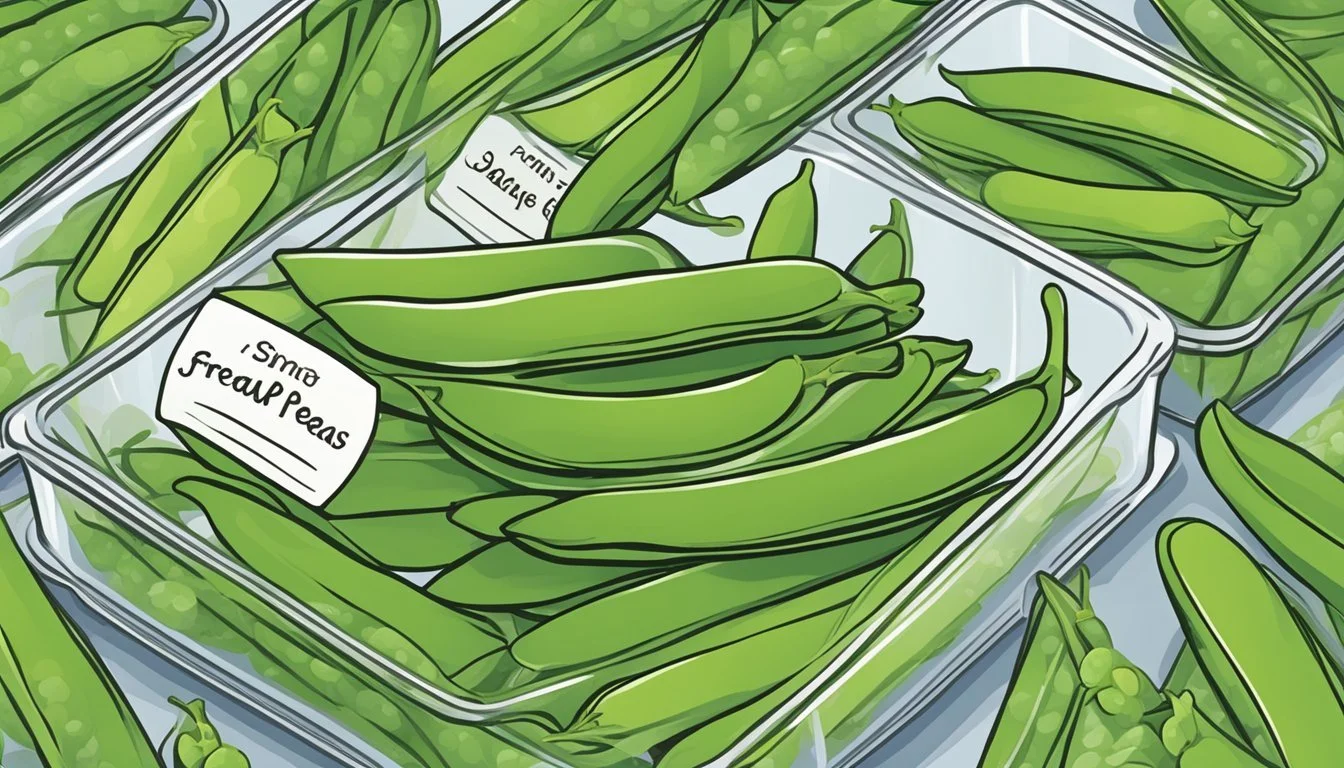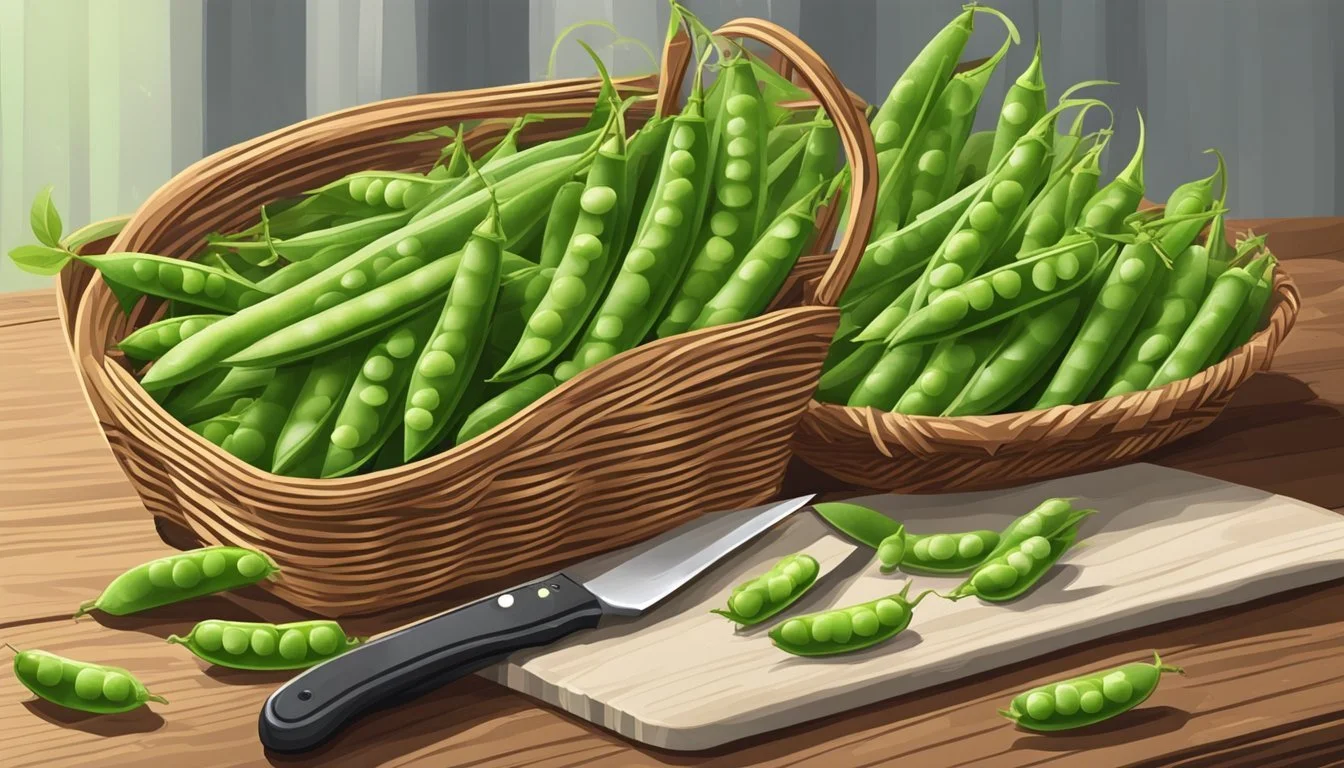How Long Do Snap Peas Last?
Shelf Life and Storage Tips
Snap peas, a crisp and sweet variety often enjoyed as a healthy snack, are a delightful addition to any meal. Their longevity, much like many fresh produce items, is influenced by factors such as storage methods, the conditions in which they were grown, and their handling post-harvest. Typically, when kept in the refrigerator, snap peas can remain fresh for a period ranging from 5 to 7 days.
Ensuring proper storage is crucial for maintaining the quality of snap peas. To optimize freshness, they should be placed in the crisper drawer of the refrigerator, ideally at temperatures between 1-4 degrees Celsius. This environment reduces moisture loss and limits air circulation, which can accelerate spoilage. If the intention is to prolong their shelf life further, snap peas can be blanched and then frozen, extending their usability up to 8 months while retaining their crunchiness and flavor.
Snap Pea Basics
Snap peas, also known as sugar snap peas, present a delightful combination of crunchy texture and sweet flavor. They are a versatile legume enjoyed in a multitude of dishes. Understanding their types and growing conditions can help ensure a successful and nutritious harvest.
Types and Varieties
Snap peas come in several varieties, with 'Sugar Ann' and 'Super Sugar Snap' being popular options. 'Sugar Ann' is known for its early maturation, while 'Super Sugar Snap' is valued for its disease resistance.
Ideal Growing Conditions
For optimal growth, snap peas require full sun and well-draining soil, enhanced with compost or organic materials. A soil pH between 5.5 and 7.0 is ideal. Prior to planting, mixing in a nitrogen-rich fertilizer can be beneficial.
Harvesting Practices
Snap peas should be harvested when the pods are plump but before the seeds mature. This typically occurs 40 to 70 days after sowing. Frequent harvesting can encourage additional production.
Nutritional Profile
Rich in fiber and nutrients, snap peas are a healthy addition to any diet. Low in calories and containing vitamins like Vitamin C and K, they are an excellent choice for health-conscious consumers.
Culinary Uses
They are a staple in a range of dishes including salads, stir-fries, and casseroles. Their natural sweetness can be complemented with herbs like mint or used as a contrast to more savory ingredients.
Flavor and Texture
Snap peas are prized for their sweet flavor and crunchy texture. Eaten whole, their edible pod differentiates them from the more traditional English peas.
Common Pests and Diseases
Key threats include aphids, fusarium wilt, and powdery mildew. Selecting disease-resistant varieties and practicing crop rotation can help mitigate these risks.
Botanical Classification
The botanical name for snap peas is Pisum sativum var. macrocarpon. Sharing a family with beans and lentils, snap peas are an edible pod pea, distinguished from snow peas and garden peas by their fully rounded pod.
Storing Snap Peas
Proper storage of snap peas is crucial to maintaining their quality and extending their shelf life. From refrigeration to freezing techniques, understanding the right methods can ensure that your snap peas remain fresh and flavorful for as long as possible.
Refrigeration Best Practices
To retain freshness, snap peas should be kept in the refrigerator within a crisper drawer to maintain the appropriate humidity level. Prior to refrigeration:
Wash the snap peas in cool water.
Dry them thoroughly to prevent excess moisture, which can lead to spoilage.
Store them in an airtight container or a plastic bag with a paper towel to absorb any residual moisture.
Extending Freshness
Snap peas maintain the best quality when consumed within 3-5 days of storage in the refrigerator. To extend their shelf life:
Do not wash them until you are ready to eat or prepare them, as excess moisture can accelerate spoilage.
Keep them away from fruits that emit ethylene gas like apples or bananas, which can reduce the freshness of the snap peas.
Freezing Techniques
For long-term storage, snap peas can be frozen, preserving their texture and color for up to 8 months. Here's how to freeze them:
Blanch the snap peas in boiling water for 1-2 minutes.
Immediately chill them in ice water.
Drain and dry thoroughly.
Place the snap peas in freezer bags, removing as much air as possible before sealing.
Identifying Spoilage
Be aware of signs that indicate your snap peas have gone bad:
Smell: An off odor is a clear sign of spoilage.
Color: Any discoloration or loss of bright green color might indicate they are past their prime.
Texture: If the pods begin to feel slimy or overly soft, they should not be consumed.
Mold: Visible mold growth is a definite indication that the snap peas should be discarded.
Safe Handling and Preparation
To ensure safety and maintain quality when handling snap peas:
Always wash your hands before and after handling fresh produce.
Wash the snap peas in cool running water just before preparing or eating them, even if they will be cooked.
Cooked snap peas should be refrigerated within two hours of cooking and consumed within three to four days for best quality and safety.
Utilization in Cooking
Snap peas contribute both a sweet flavor and a crisp texture to a variety of dishes. They are versatile in the kitchen, transitioning seamlessly from raw salads to heated entrees.
Preparing for Dishes
Before incorporating snap peas into a dish, one should thoroughly wash them to remove any dirt or residue. Trimming the ends and removing the strings along the seam enhances their texture. Snap peas can be used whole, sliced or chopped depending on the recipe requirement.
Cooking Methods
Snap peas cook quickly, retaining their color and crispness across various methods. Popular cooking methods include:
Sautéing over medium-high heat often with oil for about 3-5 minutes until they are bright green and tender yet crisp.
Boiling in salted water for just a minute or two, then immediately plunging into ice water to stop the cooking process and preserve their vibrant color.
Steaming for a few minutes which allows the peas to maintain maximum nutritional value, flavor, and texture.
Recipe Ideas
The sweetness and crunch of snap peas make them a delightful addition to numerous dishes. They shine in:
Stir-fries, incorporating a bright crunch.
Salads, raw for a refreshing bite.
Casseroles, where they add texture contrast.
Pairing with Other Foods
The flavor of snap peas complements many ingredients. They pair exceptionally well with:
Mint, for a refreshing zest.
Fellow beans, to create a mixture of textures.
Meat dishes, offering a counterbalance in flavor and texture.
Preservation and Leftovers
To preserve snap peas, one can:
Freeze them by blanching first in boiling water, followed by a plunge into ice water, drying, and placing in freezer-safe bags where they maintain quality for several months.
Store cooked leftovers in the refrigerator where they remain safe to consume for a few days, maintaining their quality best when kept at a consistent, cold temperature.
Food Safety
Eating snap peas is typically safe when they are properly handled and cooked. However, it is important to:
Ensure snap peas are cooked to the appropriate temperature to guarantee safety.
Wash the peas thoroughly before any type of preparation to remove potential contaminants.



